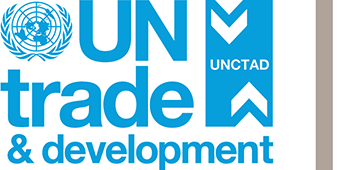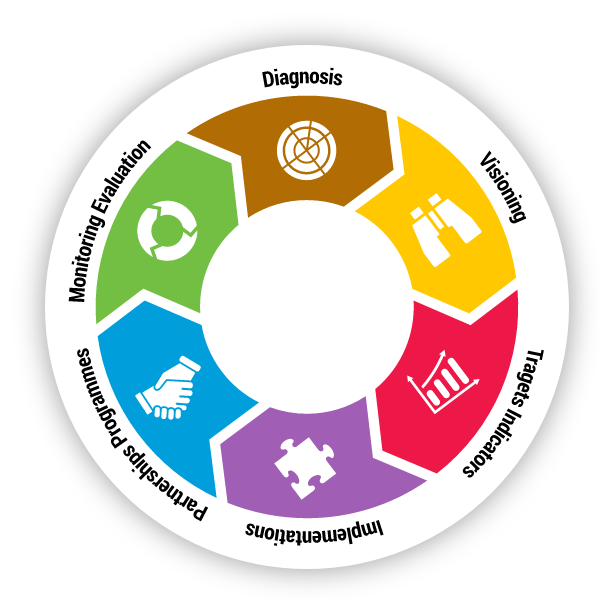Developing a sustainable freight transport strategy requires a clear Vision of how the future freight transport sector would look like. A vision sets the foundation for preparing and implementing a sustainable freight transport strategy and the visioning process helps articulate a big-picture orientation, aligned actions and outcomes, as well as a focused plan. A vision statement is usually broad and intended to be compelling, inspiring and uncontroversial. It sets out the overarching desired outcomes and leads to well-defined goals and objectives. The vision statement often includes a desired goal across the three dimensions of sustainability, a timeline, and, an inspirational quote that can motivate all the stakeholders and build momentum towards new approaches and policies.
Vision statement
To develop a vision, which adequately reflects local needs; it is necessary to have consultations, whether formal or informal, with a broad range of stakeholders, particularly the freight transport community from the private sector that had been identified during the Diagnosis step. The visioning process requires a consensus given the potentially conflicting priorities of the various stakeholders involved and the wide range of elements that underpin the economic, social, and environmental dimensions of sustainable freight transport. Consultations during the visioning exercise can help identify ways in which the diverse freight transport perspectives can best be integrated into the sustainable freight transport planning process. Such consultations should take into account the needs of all affected parties, including smaller players such as single owner-drivers, small and medium-sized enterprises (SMEs) and small shippers. The vision statement should also result from a collaborative effort among the various stakeholders.
Goal setting
A set of goals should support the vision statement to provide strategic direction to the sustainable freight transport strategy. These goals should be framed as broad statements that describe the desired end-result. A vision statement can have many goal statements (see tables below for relevant examples).
As noted above, a broad vision statement helps identify the strategic elements and priorities that serve as the basis for developing more detailed goals, objectives, and corresponding targets and policies. For example, if a goal is to improve the mode share of waterways or shipping, then the focus areas may include carrying out port improvements, enhancing interconnectivity with highways, and, ensuring the availability of relevant infrastructure. Under an environmental goal for example, more attention would probably be given to concerns such as air pollutant and GHG emissions, water and soil quality, noise, etc.
Arizona state freight transport plan – Vision and goals
| Vision | Goals | Goal Statements |
|---|---|---|
Arizona’s freight transportation system enhances economic competitiveness and quality growth through effective system performance and management | Economic competitiveness | Increased economic activity, investment, and high paying jobs |
| Increase trade | ||
| Increase system performance | Increase mobility and multimodal accessibility | |
| Increase safety and security | ||
| Increase system efficiency and reliability | ||
| Minimize negative social and environmental impacts | ||
| Improve system management | Ensure system preservation and maintenance | |
| Work in partnership | ||
| Ensure good fiscal stewardship | ||
| Increase effective performance monitoring | ||
| Link freight transport with land use | ||
| Increase smart network expansion |
Examples of vision statements in the freight transport sector
| Name | Market/Scope | Vision/Goal |
|---|---|---|
| Sustainable Business Council: Low carbon freight pathway (New Zealand) | National | The SBC target is to halve heavy freight (2018 base year) emissions by 2030 so the sector is on a firm trajectory to net zero by 2050. |
| Port Authority of Valencia Strategy towards Zero Emissions by 2030 (Spain) | National, Port Authority | The Valenciaport cluster has set itself the ambitious goal of making Valencia a zero net emissions port by 2030. The aim of the project presented here is to implement the strategy that will enable the decarbonisation of the port of Valencia. |
| Future of Freight: A Long Term Plan (United Kingdom) | National | A freight and logistics sector that is cost-efficient, reliable, resilient, environmentally sustainable and valued by society. |
| Port of Amsterdam Strategy 2021-2025 (Netherlands) | Port, City | We envision the Amsterdam port region being more than a transhipment and transit port in 2030. It will be a dynamic international metropolitan port where international industry and the local circular economy converge. The point where global cargo flows and regional recycling meet and a base for local energy production, manufacturing, logistics and business and financial services. This interconnection of flows and sectors will enable us to mobilise knowledge and skills to achieve accelerated innovation together. |
| Canadian Green Shipping Corridors Framework (Canada) | National, supply chain | Reducing emissions by 2023 and reaching net-zero emissions by 2050 in the marine sector is a process that requires different solutions, technologies or approaches depending on the type of vessel and where it operates. Green shipping corridors are an important part of this process as they can help speed up how we develop, test and use scalable net-zero fuels and technologies. They rely on voluntary participation, building on existing relationships to facilitate the identification, testing and adoption of new technologies and fuels in established maritime shipping routes. Green shipping corridors may also create opportunities where we can reduce other environmental impacts of marine transportation. Canada has developed a national green shipping corridors framework to guide the people and organizations who are developing the green shipping corridors. To make sure that green shipping corridors are implemented consistently, our framework allows and empowers all parties to work together to eliminate greenhouse gas emissions and tackle the climate crisis. This framework will showcase Canada's leadership in reducing the environmental impacts of our marine transportation sector, and help Canada stay competitive. Being at the forefront of reducing marine emissions will create new opportunities for Canadian clean tech and clean fuel innovators, and contribute to Canada's economic growth and prosperity. |
| Smartway Initiative (US Environmental Protection Agency) | Shipper, supply chain manager, carrier, retailer, wholesaler, freight transport/logistics, service provider | Help companies advance supply chain sustainability by measuring, benchmarking, and freight transportation efficiency. |
| California Sustainable Freight Action Plan (United States) | State | Utilise a partnership of federal, State, regional, local, community, and industry stakeholders to move freight in California on a modern, safe, integrated, and resilient system that continues to support California’s economy, jobs, and healthy, liveable communities. Transporting freight reliably and efficiently by zero-emission equipment everywhere feasible, and near-zero emission equipment powered by clean, low-carbon renewable fuels everywhere else. |
| Northern Corridor Strategic Plan 2017-2021 (East Africa: NCTTA) | Transport Transit Corridor | NCTTCA's vision is to be a Smart, Sustainable, Economic and most Competitive Trade and Transport Corridor in Africa. |
| Pacific Blue Shipping Partnership (Fiji, Republic of Marshall Islands) | Regional | The Pacific Blue Shipping Partnership is an ambitious country-driven initiative for a large-scale blended finance investment to catalyse a multi-country transition to sustainable, resilient, and low carbon shipping. The PBSP targets domestic shipping to zero carbon by 2050 with a 40% reduction by 2030. |
| DHL | Shipper, supply chain manager, carrier, retailer, wholesaler, freight transport/logistics, service provider | Vision is to be The Logistics Company for the World. |
| A.P. Møller - Mærsk A | Shipping company | A.P. Moller - Maersk enables its customers to trade and grow by transporting goods anywhere. Our business model supports our vision of providing truly integrated logistics that create value for our customers. |
Objective setting
Once the goals have been identified, the next step is to formulate a set of objectives. While goals relate to the "big picture" or desired end-results, the objectives could be both broad-based and/or specific and measurable i.e. outcome, output, and activity-based objectives.
The objective answers the question, "What do we ultimately want to achieve through the sustainable freight transport strategy? It should include or lead to the development of targets and KPIs that are required to support effective decision-making. This is further detailed in the step dealing with Targets and Indicators.
Objectives must be precise, sufficiently concrete and not be open to varying interpretations by different stakeholders. Such objectives are often known as SMART objectives that are specific, measurable, accepted, realistic, and time-bound.
Specific enough to guide the formulation of policies, investments, and actions for achieving the objective without dictating the approach.
Measurable to facilitate quantitative and qualitative evaluations by clarifying how much should be achieved.
Agreed by stakeholders through consensus on a common objective.
Realistic so that it can be reasonably accomplished while bearing in mind resource limitations and competing demands.
Time-bound by identifying a timeframe for completion.
For example, if the diagnosis exercise had established that the level of ‘rail freight usage is low’, relevant stakeholders could decide to adopt the following vision: “safe, reliable and efficient movement of freight”. They could also agree on the following goal: “increase rail freight mode share”. To achieve this goal, objectives that are underpinned by the SMART principle may involve increasing the share of rail freight transport by 50% by 2030. They may also involve increasing railway investments by 30% and the fuel tax for diesel by 5%. The example in table 3 how the Vision, Goal and Objectives can be interlinked.
Examples of vision, goals and objectives
| A vision statement is a broad statement intended to be compelling, inspiring and non-controversial | A GOAL is a broad statement that describes the desired end state | An OBJECTIVE is a specific, measurable statement that supports achievement of a goal |
Example – City | ||
| Healthy, prosperous, and livable city | Enhance the quality of life for all populations, Reduce contribution to climate change and improve resilience, Reduce citywide traffic congestion. | Reduce freight transport empty trips; Reduce logistics cost by improving fuel efficiency; Reduce congestion by improving traffic flow on the designated freight network; Reduce freight transport emissions, accidents and; Reduce freight transport noise; Increase rail freight transport mode share; Reduce logistics cost by improving fuel efficiency; Improve travel time. |
The second step of Visioning therefore builds on the quantitative and qualitative inputs and considerations of available resources and local priorities clarified in the Diagnosis step. With the vision, goals and objectives formulated, stakeholders can then identify challenges and solutions in promoting sustainable freight transport, build an action plan/matrix, and find technical assistance opportunities.
The SFT Quick Assessment therefore contributes to the Diagnosis and Visioning steps of the SFT Framework, providing a basis for stakeholders to proceed through the subsequent steps.

